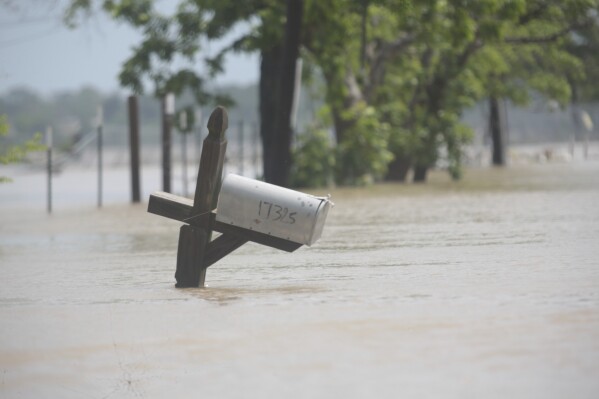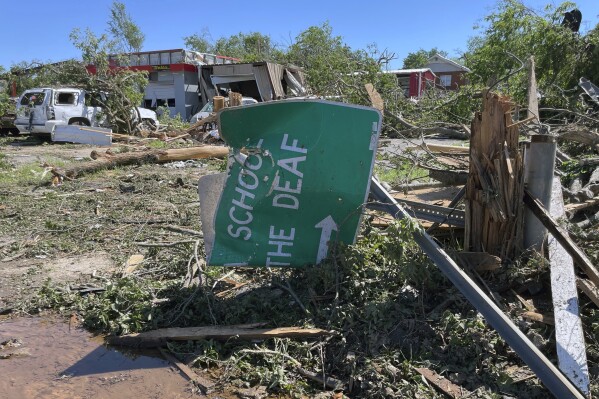Powerful storms bring tornadoes to Oklahoma, large hail to Kansas. Forecasts warn more is to come
OKLAHOMA CITY (AP) — Powerful storms have erupted in the central United States, bringing tornadoes to rural Oklahoma and large hail in parts of Kansas, with forecasters warning that the dangerous weather could stretch into the early hours of Tuesday amid a rare high-risk weather warning for the two states.
“You can’t rely on waiting to see tornadoes before sheltering tonight,” the National Weather Service said Monday.
Gusty winds and heavy rains began Monday afternoon, while tornadoes were spotted after dark skirting northern Oklahoma, including one that touched down about a 45-minute drive north of Tulsa. At one point, a storm in the small town of Covington had “produced tornadoes off and on for over an hour,” the National Weather Service said. Throughout the area, wind farm turbines spun rapidly in the wind and blinding rain.
In Kansas, some areas were pelted by apple-sized hail 3 inches (7.6 centimeters) in diameter.
The storms tore through Oklahoma as areas, including Sulphur and Holdenville, were still recovering from a tornado that killed four and left thousands without power late last month. Both the Plains and Midwest have been hammered by tornadoes this spring.



Oklahoma’s State Emergency Operations Center, which coordinates storm response from a bunker near the state Capitol, remains activated from last weekend’s deadly storms.
The Weather Service said more than 3.4 million people, 1,614 schools and 159 hospitals in Oklahoma, portions of southern Kansas and far northern Texas, faced the most severe threat for tornadoes on Monday.
Monte Tucker, a farmer and rancher in the western Oklahoma town of Sweetwater, had spent Monday putting some of his tractors and heavy equipment in barns to protect it from hail. He said he let his neighbors know they could come to his house if the weather becomes dangerous.
“We built a house 10 years ago, and my stubborn wife put her foot down and made sure we built a safe room,” Tucker said. He said the entire ground-level room is built with reinforced concrete walls.
Bill Bunting, deputy director of the Storm Prediction Center, said a high risk warning from the center is not something seen every day or every spring.
“It’s the highest level of threat we can assign,” he said.
The last time it was issued was March 31, 2023, when a massive storm system tore through parts of the South and Midwest including Arkansas, Illinois and rural Indiana.
The increased risk is due to an unusual confluence: Winds gusting up to around 75 mph (46 kph) have been blasting through Colorado’s populated Front Range region, including the Denver area, on Monday.
The winds are being created by a low pressure system north of Colorado that is also pulling up moisture from the Gulf of Mexico, fueling the risk of severe weather on the Plains, according to the National Weather Service’s Denver-area office.
Colorado is not at risk of tornadoes or thunderstorms.
The entire week is looking stormy across the U.S. The eastern U.S. and the South are expected to get the brunt of the bad weather through the rest of the week, including in Indianapolis, Memphis, Nashville, St. Louis and Cincinnati, cities where more than 21 million people live. It should be clear over the weekend.
Meanwhile, floodwaters in the Houston area began receding Monday after days of heavy rain in southeastern Texas left neighborhoods flooded and led to hundreds of high-water rescues.
___
St. John reported from Detroit, Michigan, and Salter from O’Fallon, Missouri. Associated Press writers Rio Yamat in Las Vegas, Heather Hollingsworth in Mission, Kansas, and Colleen Slevin in Denver contributed to this report.
___
Alexa St. John is an Associated Press climate solutions reporter. Follow her on X: @alexa_stjohn. Reach her at [email protected].
___
The Associated Press’ climate and environmental coverage receives financial support from multiple private foundations. AP is solely responsible for all content. Find AP’s standards for working with philanthropies, a list of supporters and funded coverage areas at AP.org.
Disclaimer: The copyright of this article belongs to the original author. Reposting this article is solely for the purpose of information dissemination and does not constitute any investment advice. If there is any infringement, please contact us immediately. We will make corrections or deletions as necessary. Thank you.





